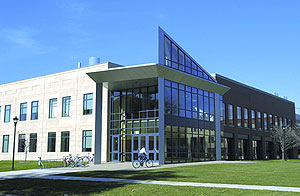

 |
||||
|
When renowned chemistry professor Frank Fanning Jewett arrived to teach at Oberlin in 1880, he had already worked at several more prosperous institutions. Whereas Yale, Harvard, and the Imperial University in Tokyo--his former haunts--had among the best-equipped chemistry labs in the world, threadbare Oberlin lacked even a decent scale for measuring chemical samples. Jewett--who went on to train aluminum industry pioneer Charles Martin Hall and Nobel laureate Robert Millikan--spent his frigid winter days crawling beneath the floorboards of Oberlin's chemistry lab, thawing water pipes with a Bunsen burner. There is no doubt that Jewett, Hall, and Millikan would be among the first to applaud the construction of the new Oberlin Science Center. Dedicated on October 4, 2002, the facility is a computer-age marvel. Take, for example, the new scanning electron microscope, which is housed in the geology facilities in Carnegie and linked electronically to "smart" classrooms in the Science Center. A physics or biology professor can walk across the street to Carnegie, place a sample in the microscope, and return to his classroom to project the magnified image on a wall-sized screen. An architectural showpiece, the building--with a budget of $55 million for construction and associated costs, and $10 million for an operations-and-maintenance endowment--is a postmodern structure sheathed in sandstone and designed to blend in with the stone facades of the venerable Carnegie Building, Finney Chapel, and Wilder Hall. The project actually joins together four structures--half of the Kettering Hall of Science, the Sperry Neuroscience Wing, the Wright Laboratory of Physics, and a new L-shaped addition that links the three buildings. Physics, chemistry, biology, and neuroscience now share one building, spurring new links between the sciences. To understand what the building means for Oberlin's future, it's necessary to understand why the College forged ahead with the largest capital construction project in its history. Since 1960, the number of science graduates at Oberlin has more than doubled and the science faculty has increased by roughly two-thirds, leading to overcrowding in the existing facilities. In addition, equipment needed for emerging fields such as molecular biology--which didn't even exist when Kettering opened in 1961--was lacking. Kettering, Wright, and Sperry were also too small to house the instruments and laboratories needed to handle an increasing emphasis on faculty and student research. Science majors are now expected to conduct research; in fact, notwithstanding Kettering's less-than-ideal conditions, 250 students co-authored journal articles with Oberlin faculty members during the past several years. The science facilities also lacked the wiring needed to equip "smart" classrooms, high-tech teaching spaces outfitted with technology that blends high-speed fiber optics, computers, and large screens, and allows classes to access electronic data from half a world away. Other liberal arts colleges had already modernized
their science facilities during a building boom in the 1980s and
1990s. With such glaring inadequacies, Oberlin was at risk of losing
the best science faculty members and the most promising The late David Love, director of sponsored programs and project administrator for the Science Center, summed up the problem this way: Oberlin could either build the new center or lose its status as a leading science college. That was an outcome no one wanted. Today, the building is such a hit that the admissions office has introduced a Science Center tour for prospective students. Once inside, students and their parents can witness Oberlin's offerings--teachers who take time to talk to them and highly sophisticated instrumentation that students themselves can use. "I've had professors talk to potential applicants for half an hour," says tour guide Rachel Schuler, a senior who plans to attend graduate school in botany. "The Cal Techs and the Harvards have more instruments, but undergraduates may never get near them." Here, in capsule form, is a tour of the new building. |
|
|
 A
New Day for Science
A
New Day for Science